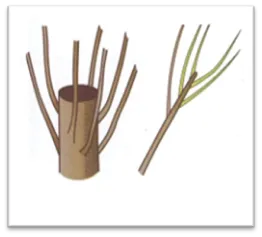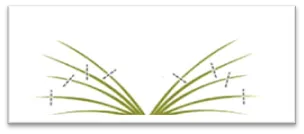By Peggy Rice, UC Master Gardener
Why prune?
- To control the size and/or shape of the plant
- To affect flower/fruit production
- To train young plants
- To remove damaged or infested growth
- To bring new vigor to an older plant
What does pruning do?
Pruning can open the plant in the center or bottom, and often promotes new branching near the pruning site.
There are two main types of pruning: Heading and Thinning
Heading: Heading refers to cutting a plant or branch back to a stub, by either cutting the main trunk (topping) or cutting a large branch to a lateral bud, or small lateral branch. Heading is also not recommended if the branch is large because the new growth will be weakly attached. However, heading can help shape a plant and reduce the spread of plant.
Topping is not recommended for mature trees because it causes injury and can distort their appearance.
Thinning removes entire branches, or cutting a branch to a lateral which is large enough to support new branches. Thinning opens up a plant, allowing more light to penetrate the canopy. Thinning doesn’t typically produce a flush of new growth but retains the normal growth habit and shape of the plant.
 |  |
Figure 1. Heading back is cutting to a stub, small lateral branch or lateral bud. From Pittenger, 2015. | Figure 2. Flush of vigorous upright and dense new growth from just below the heading cut. From Pittenger, 2015. |
When to prune: There are general rules.
- Plants that bloom in spring: prune just after flowering, in late spring or early summer
Examples: Camellia, rhododendron, leucospermum, leucadendron, forsythia, quince, viburnum, lilac, azalea, ceanothus, grevillea.
- Prune just after flowering. Flowering is a reliable indicator to properly time pruning despite variable spring weather.
- Plants that bloom in the summer or fall: prune in winter when they are dormant.
Examples: Roses, sages, crepe myrtle, hydrangea, bougainvillea, oleander, butterfly bush, potentilla, lantana.
- The winter season may vary, depending on whether your location and microclimate. If your winter isn’t clearly defined, early January is a usually good time
- Disclaimer: if it’s a plant you really love, consult references containing plant specific recommendations on pruning. Sunset Western Garden Book or search UC Master Gardeners or UC ANR references. Consult UC Master Gardeners Helpline.
- Fruit trees are more complicated. Additional information specifically for different fruit trees are available. Pruning Fruit Trees and Shade Trees and Shrubs. UC ANR. Pests in Gardens and Landscapes: Pruning fruit and shade trees and shrubs—UC IPM (ucanr.edu)
| Prune broadleaf shrubs to keep their natural shape by using mostly thinning cuts. Avoid making heading cuts or shearing the whole plant. From Pittenger, 2015. |  |
Basic Guidelines: Follow the 3Ds, 3Cs, 3Ss
3Ds: Branches can be removed at any time if they are: Dead, Diseased, Damaged
3Cs: Pruning during dormancy, remove branches that are: Competing, Crossing, Crowded
3Ss: Pruning goals, based on the plant in the landscape: Safety, Sight lines, Shape
How much to prune? This is not as easy.
- A safe rule is to prune no more than one third of the plant. However, some plants can tolerate and may need heavier pruning.
- Some landscape plants can be pruned right to the ground, others to a low mound.
- Woody plants need thinning, not heading. Do not shear. Remove entire branches to open the canopy.
- For spreading plants, such as junipers, cut upper branches to prevent shading of lower branches.
- If the plant is grafted, remove any growth below the graft union.
- Clean out dead leaves under smaller plant to reduce the possibility of disease. Leave tree leaf litter in place.
Prune spreading-type narrow leaf evergreens by cutting back longer upper branches. Cut back from a few inches to half the branch, to prevent shading of lower branches. From Pittenger, 2015. |  |
How to prune:
- Clean and sharpen tools first, removing all dirt and debris.
- Disinfect tools to prevent disease spread. Full strength Lysol is effective and least corrosive to tools. 10% bleach solution (9 parts water with one part bleach) or 70% isopropyl alcohol can also be used.
- Pruning tools include clippers, pole trimmers, and a saw, depending on limb size.
- Clippers should be the bypass type, not the anvil type, to get a clean cut without crushing.
- Pole trimmers should be bypass type, not loppers, for clean cuts.
- Make a single, sharp cut. Cut on a slant to prevent pooling of moisture which can increase risk of infection.
- Wound sealing or coatings are not recommended, since they can trap water and lead to disease.
References
Clean and Disinfect Gardening Tools and Containers. University of Minnesota Extension. Clean and disinfect gardening tools and containers | UMN Extension
Lacan, Igor. Pruning and Tree Physiology: The Bad and The Ugly. Pests in the Urban Landscape.
UC ANR. 2014. Pruning and Tree Physiology: The Bad and The Ugly - Pests in the Urban Landscape - ANR Blogs (ucanr.edu)
Lacan, Igor. The Good Side of Pruning. Pests in the Urban Landscape. UC ANR. 2014. The Good Side of Pruning - Pests in the Urban Landscape - ANR Blogs (ucanr.edu)
Landscape Management. Center for Landscape & Urban Horticulture. UC ANR. Landscape Management - Center for Landscape & Urban Horticulture (ucanr.edu)
Layland, David. Selecting the Right Pruning Tools. UC ANR. 2021. https://ucanr.edu/sites/ucmgnapa/files/205844.pdf
Pittenger, Dennis R. 2015. California Master Gardener Handbook. Second Edition. Oakland, CA:
University of California, Agriculture and Natural Resources Communication Services. p. 314-325.
Pruning with the Pros. OSU Extension Service. Pruning with the pros | OSU Extension Service (oregonstate.edu)
